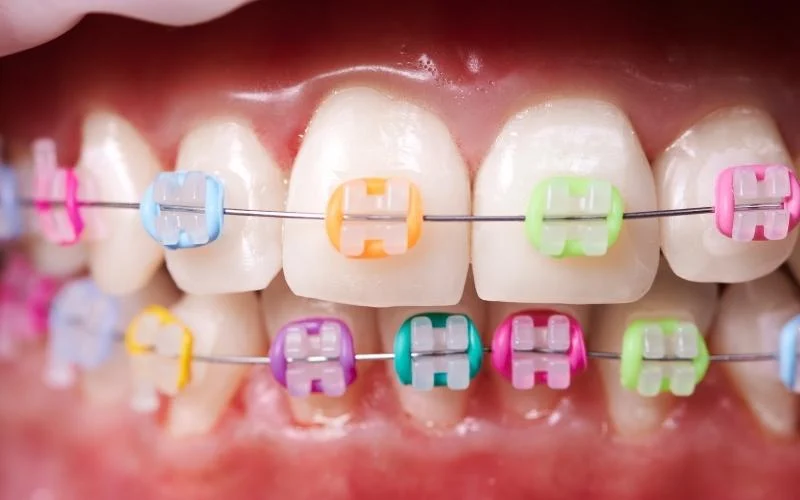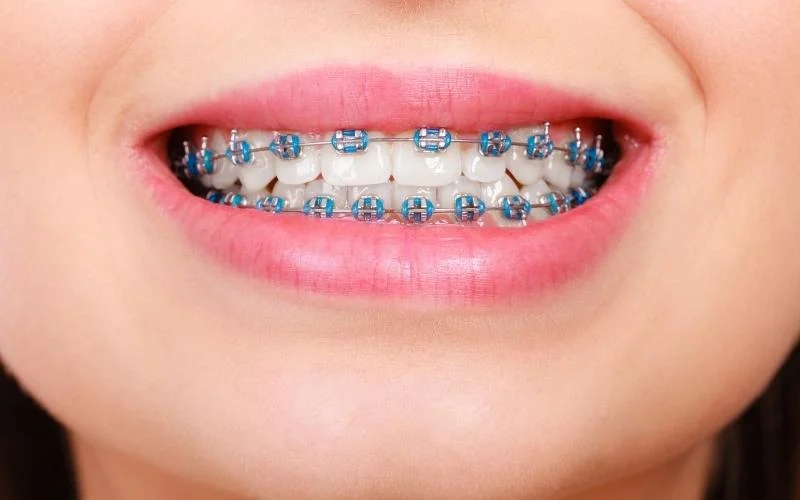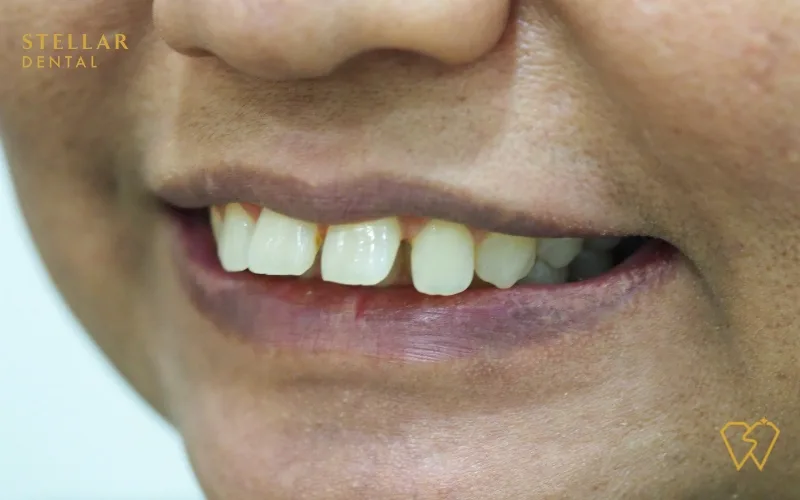The misalignment of a person’s teeth and bite, or malocclusion, can cause gum disease, jaw disorders, and problems chewing or speaking. A conventional braces can fix the teeth and bite of a person. Over time, this orthodontic treatment assists teeth in repositioning themselves correctly.
Despite numerous technological developments in orthodontics, using conventional braces to realign teeth and jaws has been the most popular, reliable, and effective orthodontic therapy for centuries.
Conventional braces consist of small brackets joined by an archwire and fastened to each tooth to gradually move your teeth into their new positions under the gentle pressure of tiny elastic bands.
This article will discuss conventional braces, their benefits and drawbacks, and how to maintain proper oral hygiene while wearing them. We have also covered the alternatives to conventional braces and possible better treatments.
What are conventional braces
Conventional braces are a fixed apparatus used to straighten the teeth. An orthodontist specializes in improving the bite and alignment of teeth. They advise using a dental brace on:
- Teeth alignment and dental crowding correction
- The front and back teeth touch in an equal bite
- Lessen the likelihood of damage to prominent teeth
- Other medical conditions like cleft lip and palate

Conventional braces are bonded or cemented to the teeth by an orthodontist. A flexible wire that slips through openings in the brackets joins and keeps them together. The orthodontist will then tighten the wire using tiny bands called ligatures.
The pressure from these braces forces and realigns the teeth. An orthodontist may tighten the wire during dental appointments to shift the jaw and teeth. They may also cement or attach a metal ring known as a band to one of the back teeth to give anchoring and support for the braces.
Additionally, elastic bands can be worn between the upper and lower jaws to allow for the movement and realignment of specific teeth while undergoing treatment.
For the duration of the braces therapy, checkups with an orthodontist are often scheduled every 4 to 6 weeks to ensure proper alignment.

Process of getting conventional braces
Initial consultation and evaluation
The orthodontic practitioner (dentist) examines the teeth physically, and radiographically and examines the patient’s dental history to make a treatment choice. Additional choices, including the type of braces and the length of therapy, are made after the initial appointment.
Installing the teeth braces
Dentists use a cheek retractor when placing dental braces to keep the teeth dry and visible. The teeth are thoroughly polished, conditioned, air-dried, and primed before the brackets are placed. Dental cement is used to bond the brackets to the teeth in the precise location identified during the initial examinations.
The cheek retractor is removed, and dental arch wires are placed after the dental braces are correctly positioned. The entire placement procedure takes about 1 hour.
Review of the teeth braces
Multiple review sessions are needed to ensure that the teeth continue to move in the desired direction. The movement of the teeth and the progress made with the dental braces are assessed at each adjustment appointment. New ties and archwires are placed as well.
Removing the teeth braces
When the teeth have been appropriately realigned, and the orthodontic treatment is complete, it’s time to take the braces off. This procedure is not difficult and is relatively simple but may take some time.
The dentist removes all the dental cement, bonds, brackets, and wires. Your dentist may advise using a retainer for some time to prevent teeth from returning to their original position.
Also read: Teeth Retainer Function, Types And Price
Benefits of conventional braces
There are many benefits and drawbacks to consider before deciding on conventional braces for your dental treatment.
Efficacy
Conventional braces, a fixed appliance, enable more accurate and controlled tooth movement, especially in difficult cases. According to a 2019 study, conventional braces were more successful than clear aligners at treating malocclusions, retention after braces removal, and rotation of the teeth.
Oral wellness
The fact that braces can enhance general oral health is another advantage. Misaligned teeth may result in issues with swallowing or chewing. Additionally, it can make them more difficult to clean, which increases the likelihood of plaque development and the danger of gum disease.

Materials
Most braces are made of strong materials, and conventional braces are particularly long-lasting. Additionally, because conventional braces are made of darker materials, they are less likely to stain.
Variety
People undergoing orthodontic treatment can also choose the color of their tiny bands(ligatures). This can make patients feel happy and stay relaxed during the procedure.

Drawbacks of conventional braces
Duration
Conventional braces treatment can take one to three years. After this period, a retainer that retains the teeth in their new places is typically required. However, this particular braces type might not provide the quickest recovery time.
Diet
A drawback of conventional braces is the necessity to closely control one’s diet and oral hygiene. Consuming sweet foods may cause plaque to accumulate around the metal brackets. The buildup could eventually result in the teeth becoming permanently stained or damaged.

Appearance
Furthermore, some people might not like how braces look. According to a 2019 study, clear aligners are more aesthetically pleasing and comfortable for many individuals than conventional braces.
Care instructions
Balanced diet and good oral hygiene are essential when taking care of braces. Brushing your teeth thoroughly when wearing braces is essential to avoid plaque accumulation and dental disorders like gingivitis.
If you have braces, you should do the following:
- Brush at least three times per day.
- Brush at least an hour after meals.
- Clean the top, bottom, and sides of the braces
A person wearing braces should also clean in between their teeth using other appropriate instruments, such as an interdental brush or floss threader. An orthodontist may offer a specific toothbrush or cleaning instrument to clean the teeth properly.

Additionally, a person should avoid chewy, sticky, or hard meals because they can easily harm braces. These consist of the following:
- Popcorn
- Nuts
- Hard, chewy candies
- Ice
- Chewing gum
- Apples and other whole hard fruits
- Uncooked veggies, like carrots
- Corn
- Hard bread like bagels or buns
- Ribs
Any hard meals should also be broken up into small, bite-sized pieces. Patients could also discover that soft food is more comfortable to eat in the initial days following the brace fitting. These foods consist of:
- Yogurt
- Soft bread
- Pasta
- Cooked or canned fruits
- Scrambled eggs
Conventional braces versus ceramic braces
Ceramic braces are made of ceramic and come in translucent or tooth-colored varieties. Some people may prefer ceramic braces because they are less noticeable than metal braces.
Research shows ceramic braces perform better in MRI scans than metal braces in picture distortion and signal loss. Ceramic braces, however, could be more expensive than metal braces as they can cost from RM1000-2000 more.
Patients with ceramic brackets may also face higher enamel demineralization than those with metal brackets. Demineralization occurs when the amount of hard minerals on the tooth’s surface decreases.
Conventional braces versus self-ligating braces
Self-ligating braces are another alternative for orthodontic therapy. Despite not requiring elastic bands to hold the brackets to the metal wire, these are comparable to conventional braces in appearance.
After every adjustment with conventional braces, most patients feel pain or discomfort. Self-ligating braces, on the other hand, adjust continuously at a steady pace.
On average, this technique costs more than conventional braces but less than lingual braces. These appliances can also provide quicker treatment than conventional braces, move teeth more effectively, and necessitate fewer orthodontist visits. Compared to conventional braces, self-ligating braces collect fewer Streptococcus mutans.
Self-ligating braces are not appropriate for all orthodontic treatment types, so a person should speak with their dentist before considering this course of action.
Read full comparison here: Self-Ligating Braces VS Conventional Braces
Conventional braces versus clear aligners / Invisible braces
Contrary to braces, Invisalign uses transparent aligners that are less apparent. Orthodontists use detachable appliances that resemble mouthguards and do not attach them to the teeth.
Invisalign uses 3D mapping and imaging software to calculate the precise force needed to shift teeth. The company then creates customized aligners that look like plastic.
According to the Invisalign website, treatment with this method usually takes up to 6 months, but it may take longer in complicated cases. To those who choose a quicker option, the treatment is often far shorter than the 1-3 years with conventional braces.
The total cost of Invisalign treatment can range up to RM15000 and above, making it more expensive than other types of dental braces.
Invisalign is the brand. There are plenty of other companies producing clear aligners as well. The price for clear aligners at Stellar Dental is RM8000-12000.
Conventional braces versus lingual braces
Lingual braces resemble conventional braces in shape. However, the orthodontist will bind the metal brackets to the back of the teeth instead of the front.
Lingual braces are rarely visible, making them an option for those who prefer to have invisible braces. Lingual braces, however, are difficult to clean. Additionally, because of this positioning, adjustments at checkups take longer.
Lingual braces can cost between RM8,000 and RM10,000, significantly more than other treatment alternatives. Furthermore, lingual braces may disrupt speech and make chewing more difficult. They are also more uncomfortable than other systems because the brackets and wires are placed so close to the tongue.
What is the conventional braces price?
The price of conventional braces in Selangor is in the range of RM4000 to RM6000. The price of conventional braces in KL is usually a little higher.
At Stellar Dental, conventional braces start from RM4500 only. The treatment period is 18-24 months and monthly installments are from RM150 only with an initial deposit as low as RM700.
If you are around Setia Alam, Shah Alam, Subang or Klang you can go to Stellar Dental Setia Alam. If you are nearer to Kota Damansara, Petaling Jaya (PJ) or Kuala Lumpur (KL), you can go to or Stellar Dental Kota Damansara to get braces treatment.
Final words
Braces are an orthodontic treatment option that helps straighten crowded or crooked teeth. The typical method of helping to align teeth is using conventional braces. However, other orthodontic treatments include lingual braces, ceramic braces, and Invisalign (clear aligners/invisible braces).
Anyone using braces should make sure they brush their teeth frequently and take care to clean the brackets, wires, and each tooth individually. Plaque and gingivitis are two dental disorders that regular brushing may help prevent. People should also monitor their nutrition to avoid plaque development and brace damage.
The degree of the malocclusion determines which treatment is good for the patient. Looking forward to getting your teeth aligned and regaining your smile? Visit Stellar Dental Clinic today and get a free consultation from highly experienced dentists.









